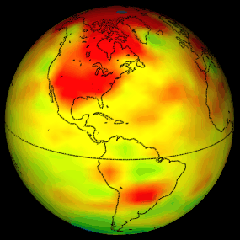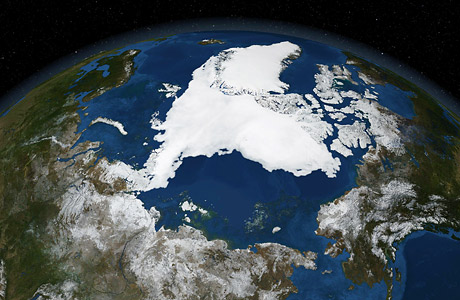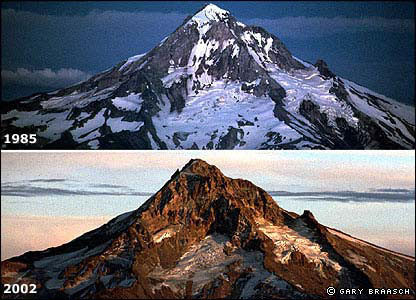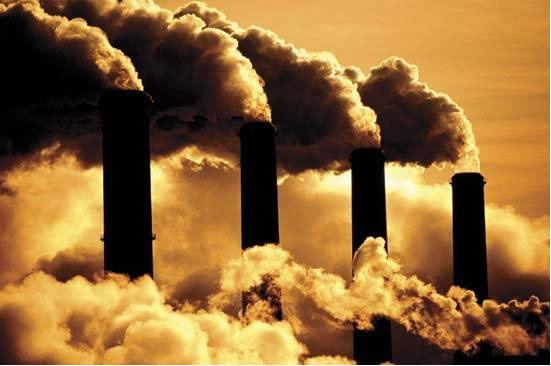|
|
|



Global
warming is the increase in the average temperature of the Earth's
near-surface air and oceans since the mid-20th century and its
projected continuation. Global surface temperature increased 0.74 ±
0.18 °C (1.33 ± 0.32 °F) during the last century. The Intergovernmental
Panel on Climate Change (IPCC) concludes that most of the observed
temperature increase since the middle of the 20th century is caused by
increasing concentrations of greenhouse gases resulting from human
activity such as fossil fuel burning and deforestation. The IPCC also
concludes that variations in natural phenomena such as solar radiation
and volcanoes produced most of the warming from pre-industrial times to
1950 and had a small cooling effect afterward. These basic conclusions
have been endorsed by more than 40 scientific societies and academies
of science,[B] including all of the national academies of science of
the major industrialized countries. A small number of scientists
dispute the consensus view. |

Climate
model projections summarized in the latest IPCC report indicate that
the global surface temperature will probably rise a further 1.1 to 6.4
°C (2.0 to 11.5 °F) during the twenty-first century. The uncertainty in
this estimate arises from the use of models with differing sensitivity
to greenhouse gas concentrations and the use of differing estimates of
future greenhouse gas emissions. Some other uncertainties include how
warming and related changes will vary from region to region around the
globe. Most studies focus on the period up to the year 2100. However,
warming is expected to continue beyond 2100 even if emissions stop,
because of the large heat capacity of the oceans and the long lifetime
of carbon dioxide in the atmosphere. |

An
increase in global temperature will cause sea levels to rise and will
change the amount and pattern of precipitation, probably including
expansion of subtropical deserts. The continuing retreat of glaciers,
permafrost and sea ice is expected, with warming being strongest in the
Arctic. Other likely effects include increases in the intensity of
extreme weather events, species extinctions, and changes in
agricultural yields. |

Political
and public debate continues regarding climate change, and what actions
(if any) to take in response. The available options are mitigation to
reduce further emissions; adaptation to reduce the damage caused by
warming; and, more speculatively, geoengineering to reverse global
warming. Most national governments have signed and ratified the Kyoto
Protocol aimed at reducing greenhouse gas emissions. |

The
most commonly discussed measure of global warming is the trend in
globally averaged temperature near the Earth's surface. Expressed as a
linear trend, this temperature rose by 0.74°C ±0.18°C over the period
1906-2005. The rate of warming over the last 50 years of that period
was almost double that for the period as a whole (0.13°C ±0.03°C per
decade, versus 0.07°C ± 0.02°C per decade). The urban heat island
effect is estimated to account for about 0.002 °C of warming per decade
since 1900.[8] Temperatures in the lower troposphere have increased
between 0.12 and 0.22 °C (0.22 and 0.4 °F) per decade since 1979,
according to satellite temperature measurements. Temperature is
believed to have been relatively stable over the one or two thousand
years before 1850, with regionally-varying fluctuations such as the
Medieval Warm Period or the Little Ice Age. |

Based
on estimates by NASA's Goddard Institute for Space Studies, 2005 was
the warmest year since reliable, widespread instrumental measurements
became available in the late 1800s, exceeding the previous record set
in 1998 by a few hundredths of a degree. Estimates prepared by the
World Meteorological Organization and the Climatic Research Unit
concluded that 2005 was the second warmest year, behind 1998.
Temperatures in 1998 were unusually warm because the strongest El Niño
in the past century occurred during that year. Global temperature is
subject to short-term fluctuations that overlay long term trends and
can temporarily mask them. The relative stability in temperature from
1999 to 2009 is consistent with such such an episode. |

Temperature
changes vary over the globe. Since 1979, land temperatures have
increased about twice as fast as ocean temperatures (0.25 °C per decade
against 0.13 °C per decade). Ocean temperatures increase more slowly
than land temperatures because of the larger effective heat capacity of
the oceans and because the ocean loses more heat by evaporation. The
Northern Hemisphere warms faster than the Southern Hemisphere because
it has more land and because it has extensive areas of seasonal snow
and sea-ice cover subject to the ice-albedo feedback. Although more
greenhouse gases are emitted in the Northern than Southern Hemisphere
this does not contribute to the difference in warming because the major
greenhouse gases persist long enough to mix between hemispheres. |

The
thermal inertia of the oceans and slow responses of other indirect
effects mean that climate can take centuries or longer to adjust to
changes in forcing. Climate commitment studies indicate that even if
greenhouse gases were stabilized at 2000 levels, a further warming of
about 0.5 °C (0.9 °F) would still occur. |

Help our planet |
|

